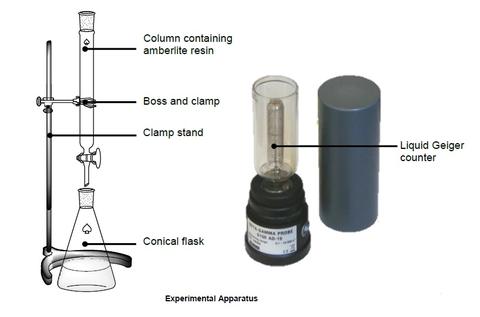
- You have been supplied with a boiling tube containing a preweighed amount of uranyl nitrate
- Measure out 100 cm3of deionised H2O and add enough of this to the boiling tube to dissolve the uranyl nitrate. Decant this into a conical flask and then add the remaining H2O.
- Pass all of this through the ion exchange column at a rate of 2-3 drops per second – the eluant should be colourless as the yellow metal ions (UO22+) have been adsorbed onto the resin. DO NOT let the ion exchange column run dry at any time.
- Wash the column with 100 cm3of deionised water.
- Pass ~200 cm3of 2 M HCl through the column and collect the yellow eluant in a beaker – this will remove the 238U and 234mPa from the resin.
- Wash the column with deionised water until the eluant is colourless – collecting it in the same beaker as the acid soln
- Transfer this eluant to a bottle labelled Uranyl residues
- Wait 5 min for concentration of 234mPa to build up on column
- Manwhile ask demonstrator to explain how the liquid Geiger counter works
- Pass ~200 cm3 5 M HCl though the column, when the eluent is yellow run 100 cm3and into the liquid Geiger counter
- Place the cap on the counter and begin taking readings every 10 seconds.
- Continue until the counts decrease to background levels
- Wash the column with ~300 cm3 of deionised water– leave enough water to cover the amberlite resin in the column
- A value can be obtained by plotting the log of the 234mPa activity (corrected for background) against time. You should plot the graph, using Excel, over an activity range of an order of magnitude for accuracy, using 6 or 7 points. Remember to take off the background activity level
Note: The column still has 234Th adsorbed on the resin. Thus, 234mPa is continually being formed and could be removed at any time by passing more HCl through the column. It is therefore a source of 234mPa as long as the 234Th lasts. This is sometimes referred to as a 234mPa cow (milked when wanted), a better name is a 234mPa generator. Generators of this type are common. The basic requirement is for a moderately long-lived isotope, which decays to a shorter-lived isotope, which can then be chemically separated from the parent. One of the most widely used is the 99mTc generator, from which it can be eluted from its 99Mo parent, to be used for bone and liver scanning.